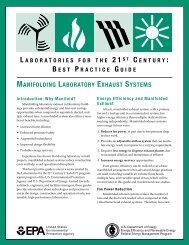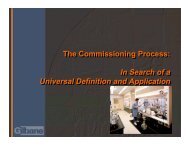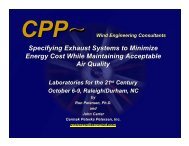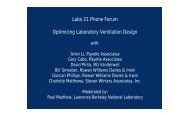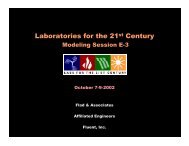naval facilities engineering command planning and design policy
naval facilities engineering command planning and design policy
naval facilities engineering command planning and design policy
You also want an ePaper? Increase the reach of your titles
YUMPU automatically turns print PDFs into web optimized ePapers that Google loves.
NAVAL FACILITIES ENGINEERING COMMANDPLANNING AND DESIGN POLICY STATEMENT - 98-03PROCUREMENT OF SUSTAINABLE FACILITIES AND INFRASTRUCTURE THROUGHARCHITECT-ENGINEER (A-E) AND RELATED CONTRACTSReferences:18 JUNE 1998a. NAVFAC Planning <strong>and</strong> Design Policy Statement 98-01, “Design of SustainableFacilities <strong>and</strong> Infrastructure” dated 18 June 1998b. NAVFAC Planning <strong>and</strong> Design Policy Statement 98-02, “Criteria Supporting theDesign of Sustainable Facilities <strong>and</strong> Infrastructure” dated 18 June 1998Attachments:1. Policy M<strong>and</strong>ates Supporting the Procurement of Sustainable Facilities <strong>and</strong>Infrastructure2. Suggested Evaluation Factors for Determining an A-E’s Knowledge <strong>and</strong> Experiencein Sustainable DesignPolicy Statement:It is the <strong>policy</strong> of the Naval Facilities Engineering Comm<strong>and</strong> (NAVFAC) to select A-Es for <strong>design</strong><strong>and</strong> related professional services on the basis of their “knowledge <strong>and</strong> demonstrated experience inapplying sustainability concepts <strong>and</strong> principles to <strong>facilities</strong> <strong>and</strong> infrastructure problems through anintegrated <strong>design</strong> approach.” This selection criteria shall be given a high degree of importancewhen used jointly with other criteria, such as professional qualifications, specialized experience <strong>and</strong>technical competence in the type of work required, capacity to perform the work, past performance<strong>and</strong> geographical location in proximity to the project location. For “Two-Phase Design-Build”projects, the above underlined requirement shall apply to both Phase 1 <strong>and</strong> Phase 2; for other<strong>design</strong>-build methods, this requirement shall apply at all appropriate stages of the selectionprocess; for other procurement methods, this requirement shall apply to all <strong>design</strong> portions of theprocess. This <strong>policy</strong> applies to renovation <strong>and</strong> alteration projects as well as new construction;applies to projects regardless of funding source or amount; applies to projects accomplished for allcustomers; <strong>and</strong> applies to <strong>design</strong> associated with all procurement methods.Purpose of Policy Statement:The purpose of this <strong>policy</strong> statement is to provide for the utilization of A-E <strong>design</strong> services such thatknowledge, skills <strong>and</strong> experience in the application of sustainable <strong>design</strong> principles <strong>and</strong> concepts isa major consideration in A-E or contractor selection. This <strong>policy</strong> applies to all A-E services,whether contracted for separately or in conjunction with construction services, as occurs whenusing <strong>design</strong>-build contracts.This <strong>policy</strong> implements the A-E selection portion of NAVFAC’s comprehensive SustainableDevelopment Program which was established to meet the Navy’s <strong>facilities</strong> infrastructure needs forimproved performance, economy <strong>and</strong> productivity, while maximizing efficiency in resourceutilization. In an integrated manner, this program addresses <strong>planning</strong>, programming, <strong>design</strong>,construction, <strong>and</strong> <strong>facilities</strong> management practices, <strong>and</strong> accommodates significant changes in1
NAVFAC’s philosophy <strong>and</strong> procedures for meeting <strong>facilities</strong> <strong>and</strong> infrastructure needs. Policiesaddressing <strong>design</strong> <strong>and</strong> criteria are found in references (a) <strong>and</strong> (b). Policies addressing <strong>planning</strong>,programming, value <strong>engineering</strong>, construction, <strong>and</strong> other areas will be issued in the near future.Background:Reference (a) indicates “It is the <strong>policy</strong> of the Naval Facilities Engineering Comm<strong>and</strong> to incorporatesustainability principles <strong>and</strong> concepts in the <strong>design</strong> of all <strong>facilities</strong> <strong>and</strong> infrastructure projects to thefullest extent possible, consistent with budget constraints <strong>and</strong> customer requirements.” Reference(a) further notes that “Traditional approaches to the <strong>planning</strong>, <strong>design</strong> <strong>and</strong> construction of <strong>facilities</strong>have not typically included a coordinated look at the environmental consequences of decisions,although areas such as reduced energy utilization have received attention over the years.”Some aspects of sustainable <strong>design</strong> are not new. Attention has been given in the past to energyconservation <strong>and</strong> efficiency, water conservation, recycling, reduced use of ozone depletingsubstances, <strong>and</strong> avoidance of the use of certain harmful substances such as asbestos.Attachment 1 captures some of the <strong>policy</strong> m<strong>and</strong>ates that are the most relevant to the procurementof A-E services for sustainable <strong>design</strong>. The comprehensive incorporation of sustainabilityprinciples <strong>and</strong> concepts into the <strong>design</strong> process through an integrated <strong>design</strong> approach must beaccomplished. NAVFAC’s Sustainable Design Pilot Project Program, together with meetings withvarious professional societies representing the A-E community, has demonstrated that <strong>design</strong> firmshave typically not been tasked by NAVFAC or other federal agencies to <strong>design</strong> projects in thismanner, although many are now capable of doing so. Given the policies previously noted, <strong>and</strong>especially the discussion on “Integrated Design” contained in Attachment 4 to reference (a), theselection of an A-E which has experience in applying sustainable <strong>design</strong> concepts <strong>and</strong> principleson an integrated <strong>design</strong> basis is essential to overall project success.Action <strong>and</strong> Procedures:To implement this <strong>policy</strong> statement, Engineering Field Divisions (EFDs), Engineering Field Activities(EFAs) <strong>and</strong> Public Works Centers (PWCs) shall apply this <strong>policy</strong>, effective with its issue date, to all<strong>design</strong>-bid-build projects <strong>and</strong> all <strong>design</strong>-build projects for which CBD announcements have notbeen made; <strong>and</strong> to all projects utilizing other procurement methods where criteria for selection of<strong>design</strong>ers can be determined or influenced. Where the A-E selection process has proceededbeyond the points noted above, this <strong>policy</strong> shall be applied on a selective basis consistent withproject requirements, customer needs <strong>and</strong> other appropriate considerations. The intent is to applythis <strong>policy</strong> to the greatest extent possible without detrimentally affecting the progress of the project.Acquisition Strategy Boards at individual EFDs, EFAs or PWCs shall determine the specificrequirements <strong>and</strong> evaluation strategies on a project by project basis. Suggested means forevaluating knowledge <strong>and</strong> experience in sustainable <strong>design</strong> are contained in Attachment 2.Points of Contact:NAVFAC Headquarters POCs for <strong>policy</strong> associated with the procurement of sustainable <strong>facilities</strong><strong>and</strong> infrastructure through A-E <strong>and</strong> related contracts are:Mike Howard, Director, Strategic Operations <strong>and</strong> Community Management, NAVFAC HQCode ACQ-021; Phone: (703) 325-7654; E-Mail: howardm@hq.navfac.navy.milTerrel M. Emmons, FAIA, Associate Director for Engineering, NAVFAC HQ Code CHENG;Phone: (703) 325-0033; E-Mail: emmonstm@hq.navfac.navy.mil; Fax: (703) 325-4450;2
Attachment 1POLICY MANDATES SUPPORTING THE PROCUREMENTOF SUSTAINABLE FACILITIES AND INFRASTRUCTUREOn 11 August 1994, the Secretary of Defense stated, “The Department of Defense must improveits environmental performance by actively implementing policies that embrace pollution preventionin all phases of the acquisition process, the procurement of goods <strong>and</strong> services, <strong>and</strong> in the lifecyclemanagement of our installations.”Both prior <strong>and</strong> subsequent to this date, selected Executive Orders <strong>and</strong> acquisition policies haverequired NAVFAC to implement certain practices that are encompassed within NAVFACSustainable Development Program. However, few of these have been translated into specificregulations. One notable exception is the requirement for recycled content in constructionmaterials.Other relevant policies includes the following:Executive Order #12873: In developing plans, drawings, work statements, specifications, or otherproduct descriptions, agencies shall consider the following factors: elimination of virgin materialrequirements; use of recovered materials; reuse of product; life-cycle cost; recyclability; use ofenvironmentally preferable products; waste prevention (including toxicity reduction or elimination); <strong>and</strong>ultimate disposal, as appropriate. These factors should be considered in acquisition <strong>planning</strong> for allprocurements <strong>and</strong> in the evaluation <strong>and</strong> award of contracts, as appropriate. Program <strong>and</strong> acquisitionmanagers should take an active role in these activities.” (Section 401)Executive Order #12902: Each agency involved in the construction of a new facility that is to be eitherowned by or leased to the Federal Government shall <strong>design</strong> <strong>and</strong> construct such facility to minimize thelife cycle cost of the facility by utilizing energy efficiency, water conservation, <strong>and</strong> solar or otherrenewable energy technologies.” (Section 306)40 Code of Federal Regulations (CFR) 247 – Comprehensive Procurement Guidelines (CPG):This is the first formal regulation implementing sustainability requirements. We expect more to follow.The Environmental Protection Agency (EPA) has <strong>design</strong>ated twenty-four items that are, or can be,manufactured using recycled <strong>and</strong> recovered materials. Construction, l<strong>and</strong>scaping <strong>and</strong> park <strong>and</strong>recreation products are among the <strong>design</strong>ated items.Federal agencies are required to purchase EPA-<strong>design</strong>ated items meeting minimum recycled contentst<strong>and</strong>ards unless they are not available within a reasonable period of time; fail to meet reasonablespecifications st<strong>and</strong>ards; are not available from two or more sources (to maintain competition); or areunreasonably priced (5% higher than comparable non-recycled products).3
Attachment 2SUGGESTED EVALUATION FACTORS FOR DETERMINING A-E’SKNOWLEDGE AND EXPERIENCE IN SUSTAINABLE DESIGN(Based, in part, on reference 2 of Attachment 2 of PDPS 98-02)♦ A-Es should be required to explain their expertise with environmentally responsible orsustainable facility <strong>design</strong>, <strong>and</strong> their specific expertise in applying “Integrated Design”concepts <strong>and</strong> methodologies.♦ In reviewing the narratives, look for comparisons to industry st<strong>and</strong>ards <strong>and</strong> broad experienceintegrating several disciplines. For example, firms who specify daylighting or energy efficientlighting but don't incorporate energy efficient building "skins" or mechanical systems have notgrasped the concept of “Integrated Design.”♦ The A-E should be required to demonstrate experience with projects that use less heating <strong>and</strong>cooling energy than the DoD <strong>design</strong> energy target. Firms may be requested to list the numberof projects <strong>and</strong>, for selected examples, briefly explain strategies used to reduce HVACenergy.♦ The A-E should be required to demonstrate experience with projects that use less electricalenergy (per square foot/meter) <strong>and</strong> less energy for lighting than industry st<strong>and</strong>ards. A-Esshould indicate any projects that are EPA Energy Star compliant. They should also providedata on LEED (Leadership in Energy <strong>and</strong> Environmental Design) ratings attained by buildingsthey recently <strong>design</strong>ed.♦ The A-E should be required to demonstrate experience with projects that have specificallyaddressed ensuring good indoor air quality, including such measures as specifying adhesiveswith low levels of volatile organic compounds (VOC), low VOC paints, low-toxic buildingmaterials, or above-code required air exchanges. Projects which are <strong>design</strong>ed withIntegrated Pest Management techniques in mind reduce the use of toxic pesticides, <strong>and</strong> alsocontribute to improved indoor air quality.♦ The A-E should be required to describe past projects demonstrating site <strong>planning</strong> that workswith the natural environment, maximizes solar energy potential <strong>and</strong> use of natural light <strong>and</strong>ventilation, <strong>and</strong> minimizes off-site storm water runoff.♦ The A-E should be required to demonstrate experience in writing specifications requiringwaste management <strong>and</strong> recycling plans for project construction <strong>and</strong> demolition (C&D). If theA-E demonstrates access to local market data for C&D material reuse <strong>and</strong> knows whatmaterials will sell <strong>and</strong> who will buy it, they should be given extra credit. A successful pastproject would demonstrate a cost effective C&D management effort that reused materials on4
site <strong>and</strong> recycled as much as possible of what they could not reuse. A 40% C&D materialdiversion from the l<strong>and</strong>fill (by weight) would be acceptable; a 75 to 80% diversion would beoutst<strong>and</strong>ing.♦ The A-E should be required to demonstrate knowledge of the EPA ComprehensiveProcurement Guidelines for recycled-content building materials <strong>and</strong> have writtenspecifications requiring the use of recycled-content materials. If the A-E has developed adatabase of suppliers, extra credit should be given – it takes a lot of time to research thepossible materials, determine their technical feasibility, <strong>and</strong> compare their costs with virginmaterialproducts.♦ The A-E should be required to demonstrate experience using environmental life-cycle analysistechniques to select building materials which minimize environmental impacts throughout theirlife cycle (especially maintenance <strong>and</strong> ultimate disposal).♦ The A-E should be required to demonstrate experience with life-cycle cost analysis. Thistechnique is the key to justifying the use of materials <strong>and</strong> systems that have a higher first cost,but pay for themselves quickly due to decreased utility costs or maintenance requirements.♦ The A-E’s submittal should provide a list of client references for sustainable <strong>design</strong>.♦ The A-E’s submittal should include a resume of the Architect/Engineer who will be in chargeof this project. Include this person's experience with sustainable <strong>design</strong> projects.♦ The A-E’s sustainable <strong>design</strong> experience should either reside within the firm or beaccommodated by means of a consultant with whom the A-E has had extensive sustainable<strong>design</strong> experience on previous projects. Simply teaming with a consultant, regardless of thatconsultants qualifications in sustainable <strong>design</strong>, but where the lead A-E has only limitedexperience in sustainable <strong>design</strong>, is unlikely to lead to success <strong>and</strong> fulfilled expectationsregarding integration of <strong>design</strong>.♦ The A-E’s submittal should detail a sample sustainable project previously <strong>design</strong>ed by the A-E. This information may include size of project (preferably above 15,000 square feet) <strong>and</strong>measures taken for:• Increased energy conservation <strong>and</strong> efficiency• Increased use of renewable energy resources• Reduction or elimination of toxic <strong>and</strong> harmful substances in <strong>facilities</strong> <strong>and</strong> their surroundingenvironments• Improvements to interior <strong>and</strong> exterior environments leading to increased productivity <strong>and</strong>better health• Efficiency in resource <strong>and</strong> materials utilization, especially water resources• Selection of materials <strong>and</strong> products based on their life-cycle environmental impacts• increased use of materials <strong>and</strong> products with recycled content• Recycling of construction waste <strong>and</strong> building materials after demolition• Reduction in harmful waste products produced during construction5
• Facility maintenance <strong>and</strong> operational practices that reduce or eliminate harmful effects onpeople <strong>and</strong> the natural environment6




